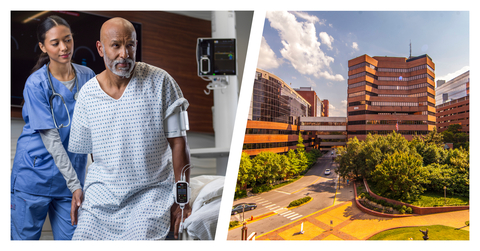Vanderbilt University Medical Center Integrates Masimo Radius VSM™ in Proactive Care Protocol to Combat Emergency Room Congestion
Renowned Healthcare Facility Launches Advanced Wireless Monitoring Technology in the Emergency Department, Reducing Wait Times and Improving Patient Prioritization

Masimo Radius VSM™ and Vanderbilt University Medical Center (Photo: Business Wire)
Radius VSM combines the reliability and accuracy of a bedside monitor with the comfort and freedom of a wearable device. With its implementation alongside Patient SafetyNet, clinicians at VUMC are able to remotely monitor vital signs in real time from centralized view stations, simplifying patient data management, enabling quicker intervention during possible deterioration, and enhancing patient safety—even while a patient is up and moving. The modular, scalable monitoring platform offers a range of physiological measurements, including Masimo SET® pulse oximetry, measure-on-inflation noninvasive blood pressure, continuous temperature, respiration rate, and 3-leadwire electrocardiography (ECG).
By monitoring ED patients with Radius VSM, VUMC is transforming spaces that were traditionally devoid of continuous monitoring into areas of proactive patient care. This level of visibility may help clinicians reduce the use of telemetry, potentially saving time and resources and improving patient throughput and prioritization to other parts of the hospital, such as the general ward or medical and surgical wards. Additionally, Radius VSM’s innovative approach not only enhances the patient and clinician experience but exemplifies how cutting-edge technology can be seamlessly integrated into high-pressure settings like the ED to help streamline continuity of care.
The initial success of VUMC’s pilot program is paving the way for an expanded rollout within the ED designed to elevate care for vulnerable patients. Moreover, the promising results may lead to adoption in other areas of the hospital, such as medical and surgical wards, broadening the impact of Masimo’s innovative technology on patient care throughout VUMC. The program also underscores both Masimo’s and VUMC’s commitment to leveraging technology to rethink and improve patient care pathways, setting a new standard for how hospitals manage patient surges in the ED and beyond.
“Rising patient acuity and volume at VUMC necessitate strategic initiatives to augment our care infrastructure,” said Neal Patel, MD, MPH, Professor of Clinical Pediatrics and Chief Informatics Officer for HealthIT at VUMC. “Wireless physiologic monitoring in the ED enhances surveillance and vigilance of each patient’s status even when they are in the waiting room.”
Bilal Muhsin, Chief Operating Officer of Masimo, said, “We are excited to partner with Vanderbilt University Medical Center to bring Radius VSM to vulnerable patients in the emergency department, where continuous monitoring is not the norm. A core tenet of our mission is to improve patient outcomes and reduce the cost of care by taking noninvasive monitoring to new sites and applications—and one of the ways we achieve that is through continued innovation. With Radius VSM, clinicians have the power of cutting-edge technology in a modular, scalable design that’s both easy to use and comfortable for the patient. The applications are virtually limitless, and I cannot wait to see how the use of this technology is expanded to enhance patient safety not only in the emergency department, but across the continuum of care.”
@Masimo | #Masimo
About Masimo
Masimo (NASDAQ: MASI) is a global medical technology company that develops and produces a wide array of industry-leading monitoring technologies, including innovative measurements, sensors, patient monitors, and automation and connectivity solutions. In addition, Masimo Consumer Audio is home to eight legendary audio brands, including Bowers & Wilkins, Denon, Marantz, and Polk Audio. Our mission is to improve life, improve patient outcomes, and reduce the cost of care. Masimo SET® Measure-through Motion and Low Perfusion™ pulse oximetry, introduced in 1995, has been shown in over 100 independent and objective studies to outperform other pulse oximetry technologies.1 Masimo SET® has also been shown to help clinicians reduce severe retinopathy of prematurity in neonates,2 improve CCHD screening in newborns,3 and, when used for continuous monitoring with Masimo Patient SafetyNet™ in post-surgical wards, reduce rapid response team activations, ICU transfers, and costs.4-7 Masimo SET® is estimated to be used on more than 200 million patients in leading hospitals and other healthcare settings around the world,8 and is the primary pulse oximetry at all 10 top
RPVi has not received FDA 510(k) clearance and is not available for sale in
References
- Published clinical studies on pulse oximetry and the benefits of Masimo SET® can be found on our website. Comparative studies include independent and objective studies which are comprised of abstracts presented at scientific meetings and peer-reviewed journal articles.
- Castillo A et al. Prevention of Retinopathy of Prematurity in Preterm Infants through Changes in Clinical Practice and SpO2 Technology. Acta Paediatr. 2011 Feb;100(2):188-92.
- de-Wahl Granelli A et al. Impact of pulse oximetry screening on the detection of duct dependent congenital heart disease: a Swedish prospective screening study in 39,821 newborns. BMJ. 2009;Jan 8;338.
- Taenzer A et al. Impact of pulse oximetry surveillance on rescue events and intensive care unit transfers: a before-and-after concurrence study. Anesthesiology. 2010:112(2):282-287.
- Taenzer A et al. Postoperative Monitoring – The Dartmouth Experience. Anesthesia Patient Safety Foundation Newsletter. Spring-Summer 2012.
- McGrath S et al. Surveillance Monitoring Management for General Care Units: Strategy, Design, and Implementation. The Joint Commission Journal on Quality and Patient Safety. 2016 Jul;42(7):293-302.
- McGrath S et al. Inpatient Respiratory Arrest Associated With Sedative and Analgesic Medications: Impact of Continuous Monitoring on Patient Mortality and Severe Morbidity. J Patient Saf. 2020 14 Mar.
- Estimate: Masimo data on file.
- https://www.newsweek.com/rankings/worlds-best-hospitals-2024/united-states
Forward-Looking Statements
This press release includes forward-looking statements as defined in Section 27A of the Securities Act of 1933 and Section 21E of the Securities Exchange Act of 1934, in connection with the Private Securities Litigation Reform Act of 1995. These forward-looking statements include, among others, statements regarding the potential effectiveness of Masimo Radius VSM® and Masimo Patient SafetyNet™, as well as VUMC’s integration of such technologies in the ED and nontraditional care spaces. These forward-looking statements are based on current expectations about future events affecting us and are subject to risks and uncertainties, all of which are difficult to predict and many of which are beyond our control and could cause our actual results to differ materially and adversely from those expressed in our forward-looking statements as a result of various risk factors, including, but not limited to: risks related to our assumptions regarding the repeatability of clinical results; risks related to our belief that Masimo's unique noninvasive measurement technologies, including Masimo Radius VSM and Masimo Patient SafetyNet, contribute to positive clinical outcomes and patient safety; risks related to our belief that Masimo noninvasive medical breakthroughs provide cost-effective solutions and unique advantages; risks related to our prediction that the initial success of VUMC’s pilot program will result in an expanded rollout within the ED and may lead to adoption in other areas of the hospital, broadening the impact of Masimo technology; risks related to COVID-19; as well as other factors discussed in the "Risk Factors" section of our most recent reports filed with the Securities and Exchange Commission ("SEC"), which may be obtained for free at the SEC's website at www.sec.gov. Although we believe that the expectations reflected in our forward-looking statements are reasonable, we do not know whether our expectations will prove correct. All forward-looking statements included in this press release are expressly qualified in their entirety by the foregoing cautionary statements. You are cautioned not to place undue reliance on these forward-looking statements, which speak only as of today's date. We do not undertake any obligation to update, amend or clarify these statements or the "Risk Factors" contained in our most recent reports filed with the SEC, whether as a result of new information, future events or otherwise, except as may be required under the applicable securities laws.
View source version on businesswire.com: https://www.businesswire.com/news/home/20241029327521/en/
Media Contact:
Masimo
Evan Lamb
949-396-3376
elamb@masimo.com
Source: Masimo







